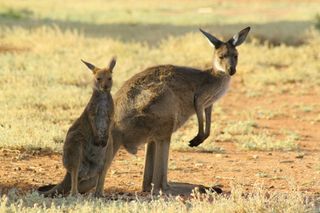Mooooove Over, Cows! Kangaroo Farts Warm the Earth, Too

Since the 1970s, it has been suggested that kangaroos don't fart — or rather, the (ahem!) gas they emit contains very little, if any, methane. But now, new research suggests this isn’t true.
Methane is naturally created by bacteria in an animal's gut. Kangaroos, cows and many other plant eaters use these bacteria to help them digest grass and leaves. In the 1970s and 1980s, research suggested that kangaroos don't produce much methane, which made scientists think they might have special low-methane-emitting bacteria living in their guts.
"The idea that kangaroos have unique gut microbes has been floating around for some time and a great deal of research has gone into discovering these apparently unique microbes," said study co-author Adam Munn, a professor in the School of Biological Sciences at the University of Wollongong in Australia. [See how animal farts impact global warming (infographic)]
The new findings, however, suggest that kangaroos actually produce about the same amount of methane as other animals of their size. Kangaroos do emit lower levels of methane than some animals, such as cows, but the marsupials are roughly on the same level as horses, the researchers said. This means kangaroos likely don't have special bacteria, after all.
One of the reasons this research is important is because understanding methane could help mitigate the effects of climate change, according to Alex Hristov, a professor of animal nutrition and diet at Pennsylvania State University.
![Methane gas fermented in the guts of farm animals contribute up to 26 percent of U.S. methane emissions. [See full infographic]](https://cdn.mos.cms.futurecdn.net/Ro3rr7KyK8fNRQbK5kBWNU-320-80.jpg)
Methane is a greenhouse gas that comes from natural sources, such as decomposing organic matter and human activities, ranging from farm animals (and the manure they produce) to oil and gas operations. Methane is less abundant in the atmosphere than carbon dioxide, but it is more effective at trapping heat (infrared radiation).
"It has a global-warming potential [about] 25 times — depends on how you look at it — that of carbon dioxide. So it's an important greenhouse gas," Hristov told Live Science. And while carbon dioxide is still the most abundant greenhouse gas produced by humans, methane emissions should not be ignored, he added.
Sign up for the Live Science daily newsletter now
Get the world’s most fascinating discoveries delivered straight to your inbox.
Cows can produce up to 200 liters of methane every day and there are an estimated 1.4 billion of them in the world, so figuring out a way to reduce those emissions could potentially help address some climate-change concerns.
In the past, scientists have tried to introduce bacteria from kangaroos into cows, in hopes of reducing methane emissions from cows. In 2004 in the United States, manure and expelled body gas from livestock (predominantly cows and pigs) contributed more than 13 millions tons of methane, according to a 2014 study published in the Journal of Geophysical Research: Atmospheres. To put that figure into context, oil and gas operations contributed 7 million tons of methane.
This kind of research could also be important to farmers, Munn said. When the bacteria break down food into methane, they’re essentially robbing the cow of some of the food's nutrients. If farmers could somehow reduce methane emissions from livestock, more nutrients would go to the cow itself, which could help them grow better.
For the new study, the scientists put 10 kangaroos inside individual sealed rooms at the University of New South Wales' Fowlers Gap Research Station and fed them food. The rooms were set up so that the scientists could measure what gases were emitted in the air. The researchers also collected the animals’ poop to measure how many nutrients were left behind, and experimented with giving the animals different amounts of food.
It may still be the case that kangaroo guts actually do hold special secrets, the researchers said. How the marsupials maintain their bacterial garden, for instance, may work differently than other plant eaters.
"What we've done here is to really show that kangaroos probably don’t have a unique microbiome," Munn said, "it''s simply that that biome interacts with the food in a different way." The next steps would be to compare these results to those of other animals, he added.
This research was published online yesterday (Nov. 4) in the Journal of Experimental Biology.
Follow Live Science @livescience, Facebook & Google+. Original article on Live Science.

